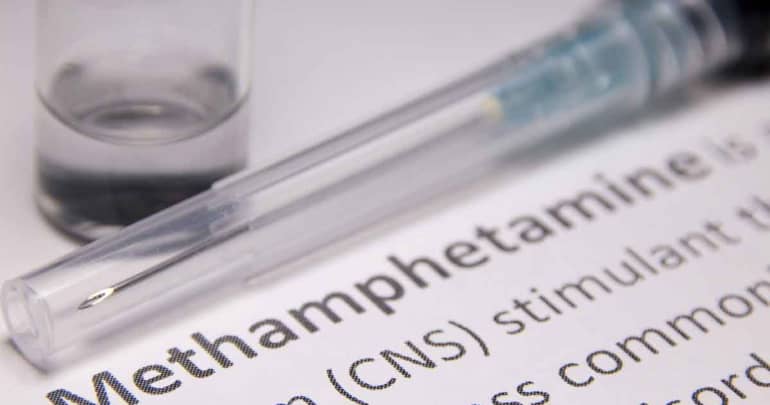Methamphetamine is an extremely powerful and addictive stimulant drug. The effects of the drug on the central nervous system are immediate and severe, making methamphetamine extremely addictive, often after just one use.
Understanding the different types of methamphetamine can be useful in knowing how to get help for someone you love or yourself.
How is Methamphetamine Used?
Methamphetamine, depending on it’s form, can be used in different ways. The most popular way to use Meth is to smoke it, but it can also be snorted, injected, or taken in pill form. No matter the route of administration, meth is a highly addictive drug that grossly effects the psychological and physical health of users.
The Different Types of Methamphetamine
Meth comes in three main forms, all of which have similar chemical properties but are slightly different in appearance and potency.

Crystal Meth or “Ice”
Crystal Methamphetamine is the most well-known and common form of this drug. It’s also the most potent and dangerous. It’s named this way because of its crystal-like appearance. Crystal is clear due to purification that is done to it during the production process. Impurities are removed leaving clear, crystalline pieces or rocks, often referred to as “ice” or “glass”.
Speed
Speed is a fine white powdered methamphetamine which is commonly snorted. It can also be pressed into tablets or mixed for injection. Created synthetically in illicit labs, speed is methamphetamine, typically combined with other substances such as glucose. Speed is considered the least potent type of methamphetamine.
Base
Base is a thick, oily, brown or yellow substance that is higher in potency and purity than speed is. The appearance of base meth can vary and it’s called by various names including, “Pure”, “Paste”, and “Wax”. Base is most often injected, and sometimes ingested orally.
When discussing types of methamphetamine, Crystal Meth is commonly called Crystal, Glass, or Ice, while the others are just called Meth. Crystal is generally seen by users to be “better” and because it’s effects are stronger, it’s more sought after.
It’s important to note that these different types of methamphetamine can be interchanged, and someone struggling with methamphetamine use may use all of these substances at different times.
The Effects of Different Types of Methamphetamine Use
Because meth is a stimulant, all of its forms can produce a “rush”, which is an experience of feelings of euphoria and a strong burst of energy.

Using stronger and more pure forms of methamphetamines such as crystal, will create very strong effects, while use of base or powder will give a slightly reduced effect.
Short term effects of methamphetamine use include euphoria, increased attention and activity, wakefulness, decreased fatigue, increased respiration, rapid or irregular heartbeat, and hyperthermia.
Long term effects of methamphetamine use are often very concerning. The list of effects is long, and includes addiction, psychosis, permanent changes in brain structure, mental and physical deficits, memory loss, aggression, mood disturbances, dental problems, and weight loss.
Physical Effects of Methamphetamine Use
You can often see physical signs of methamphetamine use on a person’s body, including skin issues, tooth decay, and abnormal gait. This is because long term use of methamphetamines starts to break down pathways in the brain that regulate the body and it’s healing processes.
Skin sores are typically caused by scratching and picking that users do because while using they imagine bugs or other things crawling on them.
Dental problems are thought to be caused by both poor nutrition, and teeth grinding caused by using the drug.
Psychological Effects of Methamphetamine Use
Being such a potent stimulant, methamphetamine has a direct effect on the brain, and therefore on psychological and mental health. Meth use releases an extremely large amount of dopamine in the brain, and will, with time, take over the production of this neurotransmitter.

Because dopamine is responsible for many of our feelings and mood, meth use can cause depression, anxiety, suicidal thoughts, and self-harming behaviors.
Long term use can lead to brain damage that can show up as mental illness that is resistant to treatment, aggression and anger issues, hallucinations and paranoia, or abnormal motor activity. In some patients we may see deficits in thinking or memory, and increased distractibility.
Risks of Methamphetamine Use
Methamphetamine use can lead to dependency, create health problems, and be fatal.
Each type of methamphetamine carries different specific risks.
Use of crystal meth or other fast acting types of methamphetamine can create high levels of tolerance and lead to binges, where a user will repeatedly use as the drug starts to wear off, in order to keep their high.
Injecting or smoking meth has been linked to an increased risk of addiction, more so than someone using the drug orally.
However, oral use, because it doesn’t give an effect right away, can lead to overdose as a user might take more than required because they don’t feel the high soon enough.
Recovery from Methamphetamine Use
While all of these long term effects sound scary and grim, the good news is that medical studies have shown that physical and mental recovery from methamphetamine use is possible. The effects on the brain are at least partially reversible, and recovered methamphetamine addicts can live a healthy life free from drugs.
Recovery from different types of methamphetamine use takes time and effort, and here at Hawaii Island Recovery, we are ready to help you take the first step.
Get Help Today!
Call us toll-free today to learn about the programs and support you or a loved one will receive when you seek treatment with us.
866-390-5070 Hawaii Island Recovery
Hawaii Island Recovery 










